|
 |
|
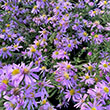
Pink Blooms. Dwarf Clump Forming. Tolerates Clay. USDA Zone 4-8
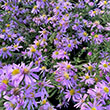
Height: 16 inches
Spread: 24 inches
Sunlight: full sun partial shade
Hardiness Zone: 3a
Other Names: Michaelmas Daisy
Description:
Mounds of narrow, dark green foliage are covered with pink daisy-like flowers, adding a pop of color to autumn days; dwarf compact habit, ideal for patio containers, borders or garden beds; beautiful added to fresh cut arrangements; low maintenance
Ornamental Features:
Woods Pink Aster has masses of beautiful pink daisy flowers with yellow eyes at the ends of the stems from early to late fall, which are most effective when planted in groupings. The flowers are excellent for cutting. Its narrow leaves remain dark green in color throughout the season.
Landscape Attributes:
Woods Pink Aster is a dense herbaceous perennial with a mounded form. Its relatively fine texture sets it apart from other garden plants with less refined foliage.
This is a relatively low maintenance plant, and is best cleaned up in early spring before it resumes active growth for the season. It is a good choice for attracting butterflies to your yard, but is not particularly attractive to deer who tend to leave it alone in favor of tastier treats. Gardeners should be aware of the following characteristic(s) that may warrant special consideration: Disease
Woods Pink Aster is recommended for the following landscape applications:
- Mass Planting
- General Garden Use
- Container Planting
Planting & Growing:
Woods Pink Aster will grow to be about 16 inches tall at maturity, with a spread of 24 inches. Its foliage tends to remain dense right to the ground, not requiring facer plants in front. It grows at a medium rate, and under ideal conditions can be expected to live for approximately 10 years. As an herbaceous perennial, this plant will usually die back to the crown each winter, and will regrow from the base each spring. Be careful not to disturb the crown in late winter when it may not be readily seen!
This plant does best in full sun to partial shade. It prefers to grow in average to moist conditions, and shouldn't be allowed to dry out. It is not particular as to soil type or pH. It is somewhat tolerant of urban pollution. This particular variety is an interspecific hybrid. It can be propagated by division; however, as a cultivated variety, be aware that it may be subject to certain restrictions or prohibitions on propagation.
Woods Pink Aster is a fine choice for the garden, but it is also a good selection for planting in outdoor pots and containers. It is often used as a 'filler' in the 'spiller-thriller-filler' container combination, providing a mass of flowers against which the thriller plants stand out. Note that when growing plants in outdoor containers and baskets, they may require more frequent waterings than they would in the yard or garden.
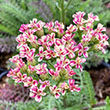
Carefree, compact, early-flowering yarrow with vibrant blooms and fern-like foliage. USDA 4-9

Compact with fern-like foliage and lemon to mustard yellow blooms. Blooms early summer to early fall. USDA 4-9
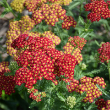
Height: 3 feet
Spread: 3 feet
Sunlight: full sun
Hardiness Zone: 2b
Description:
A lovely, fast growing perennial with an upright habit; featuring ferny green leaves and peach, orange and yellow colored blooms during the summer months; perfect addition to garden beds, borders and fresh cut arrangements
Ornamental Features:
Terra Cotta Yarrow is bathed in stunning harvest gold flat-top flowers with buttery yellow overtones at the ends of the stems from early to late summer. The flowers are excellent for cutting. Its attractive tomentose ferny leaves remain grayish green in color throughout the season.
Landscape Attributes:
Terra Cotta Yarrow is an herbaceous perennial with an upright spreading habit of growth. It brings an extremely fine and delicate texture to the garden composition and should be used to full effect.
This is a high maintenance plant that will require regular care and upkeep, and is best cleaned up in early spring before it resumes active growth for the season. It is a good choice for attracting bees, butterflies and hummingbirds to your yard, but is not particularly attractive to deer who tend to leave it alone in favor of tastier treats. Gardeners should be aware of the following characteristic(s) that may warrant special consideration;
- Spreading
- Self-Seeding
Terra Cotta Yarrow is recommended for the following landscape applications:
- Mass Planting
- Border Edging
- General Garden Use
- Groundcover
- Naturalizing And Woodland Gardens
- Container Planting
- Planting & Growing
Terra Cotta Yarrow will grow to be about 3 feet tall at maturity, with a spread of 3 feet. It grows at a fast rate, and under ideal conditions can be expected to live for approximately 10 years. As an herbaceous perennial, this plant will usually die back to the crown each winter, and will regrow from the base each spring. Be careful not to disturb the crown in late winter when it may not be readily seen!
This plant should only be grown in full sunlight. It prefers to grow in average to dry locations, and dislikes excessive moisture. It is considered to be drought-tolerant, and thus makes an ideal choice for a low-water garden or xeriscape application. It is not particular as to soil pH, but grows best in poor soils. It is highly tolerant of urban pollution and will even thrive in inner city environments. This particular variety is an interspecific hybrid. It can be propagated by division; however, as a cultivated variety, be aware that it may be subject to certain restrictions or prohibitions on propagation.
Terra Cotta Yarrow is a fine choice for the garden, but it is also a good selection for planting in outdoor pots and containers. With its upright habit of growth, it is best suited for use as a 'thriller' in the 'spiller-thriller-filler' container combination; plant it near the center of the pot, surrounded by smaller plants and those that spill over the edges. It is even sizeable enough that it can be grown alone in a suitable container. Note that when growing plants in outdoor containers and baskets, they may require more frequent waterings than they would in the yard or garden.
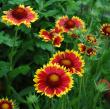
Prolific yellow-tipped red blooms. Compact. USDA 3-9
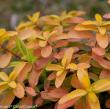
Bright yellow flowers bloom in spring to late summer, followed by attractive yellow to orange berries. Deer resistant. USDA 5-9
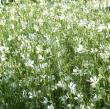
Pure white blooms. Compact. Tolerates poor soils. USDA 5-9
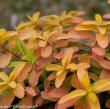
Bright yellow flowers bloom in spring to late summer, followed by attractive yellow to orange berries. Deer resistant. USDA 5-9